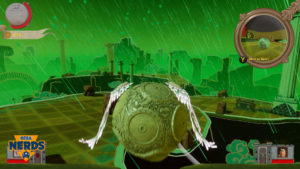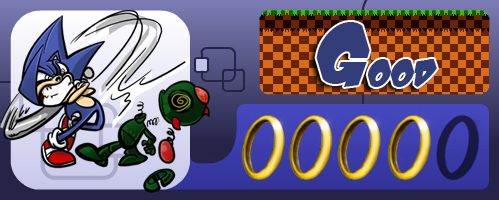Review: Rock of Ages 2: Bigger and Boulder
What happens when you mix tower defense with Super Monkey Ball?
QUICK LOOK
GOOD
GOOD
Rock of Ages 2's quirky art style, coupled with fun gameplay and a cracking soundtrack make it one of the more unique games we've seen in some time.
Since SEGA acquired Atlus’ parent company Index Holdings back in 2013, SEGA Nerds have had an additional boost of titles to enjoy under the SEGA umbrella, not least the Persona and Shin Megami Tensei franchises.
This extension of franchises now includes the likes of Rock of Ages. Developed by ACE Team, the first game was released on Xbox Live Arcade, PlayStation Network and Windows back in 2011, and while Rock of Ages wasn’t perhaps a game that set the world on fire, it was very well received and left fans craving for more.
So, it’s great to see, some six years later, that ACE Team and Atlus are at it again with Rock of Ages 2: Bigger and Boulder.
Take Super Monkey Ball, remove the monkey…

For those who the original passed them by, the best analogy for Rock of Ages is to take a tower defense game and mix it with Super Monkey Ball. The objective of the game is to defend your castle, using a variety of weapons, barriers and traps, while attacking your enemy’s castle and being the first to break down the door and squash the occupant (your enemy) inside.
The franchise features two main gameplay components, firstly you place your series of weapons and traps along the level – a downhill obstacle course – in the best way to either damage your enemy’s boulder or destroy it completely. That’s the tower defense side of things.
The second part of the gameplay involves you taking direct control of your giant boulder, where you need to navigate the course, avoiding enemy projectiles and traps, to smash down the door of their castle. The more damage your boulder receives, the weaker the impact damage will be on their castle and should your boulder lose all its health, it will be destroyed. This is the Super Monkey Ball part of the game, although, unlike Monkey Ball you control the ball/boulder directly, you don’t move the ground… oh, and there are no monkeys in the game either (shame).
If you enjoyed the gameplay in the original Rock of Ages, then you’ll be happy to hear that Rock of Ages 2 is very much more of the same, just bigger and boulder… err bolder.

Its ACE Team’s Flying Circus
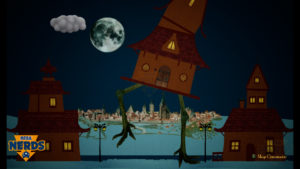 Believe it or not, the game has a story to it, which lends itself in alignment with its name.
Believe it or not, the game has a story to it, which lends itself in alignment with its name.
In Bigger and Boulder, you follow Atlas, the Titan from Greek mythology who was forced to hold the sky upon his back. Though Bigger and Boulder has taken the modern misconception here and adopted the idea that Atlas was holding the Earth on his back – but this common error is forgivable, as it works well with the story.
Anyway, Atlas is doing his thing, holding up the Earth, when God comes along and distracts him. Atlas accidentally drops the Earth and it falls to the heavens below. Panicking, he replaces the Earth with a large boulder. When God notices the Earth looks different he goes to put on his glasses to inspect it. As God is looking away, Atlas jumps from his plinth, still holding his boulder, and as he falls through space, he lands on Earth.
That bit is a little weird, as he was a giant holding the Earth, but is suddenly smaller, more human sized, and can now walk around on the planet, along with the boulder he brought down with him.
Now on Earth, Atlas is walking through notable periods of time, meeting various historical and mythological figures, all of whom have been depicted (in real life) in paintings and other works of art, such as statues or books – from the likes of Henry VIII, to Medusa, to William Wallace and a demon that blew up Mount Vesuvius. Each historical/fictional character you meet, you end up fighting against.
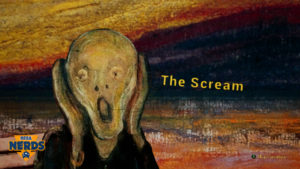 One of the great things about Rock of Ages is the fun art style and sense of humour, which has returned for Bigger and Boulder. The most accurate and best likeness for the art and humour is Monty Python’s Flying Circus – ACE Team has taken samples of works of art and animated them in a similar way to Monty Python’s animated scenes, right down to the absolute insanity, silliness and audio style, with mumbles and odd noises.
One of the great things about Rock of Ages is the fun art style and sense of humour, which has returned for Bigger and Boulder. The most accurate and best likeness for the art and humour is Monty Python’s Flying Circus – ACE Team has taken samples of works of art and animated them in a similar way to Monty Python’s animated scenes, right down to the absolute insanity, silliness and audio style, with mumbles and odd noises.
For those not familiar with Monty Python’s animation, think South Park, Salad Fingers or Apollo Gauntlet, where you have flat, paper-like, cut-out 2D images – taking figures from old paintings and animating them.
Granted, humour is always a matter of taste and if you really hated Monty Python’s animated scenes, there’s a chance you’ll hate these, but I loved them. While they are not entirely original in design or concept, this style is uncommon enough to give Rock of Ages a unique feeling and one that I really enjoyed throughout the game.
A brief lesson in history and mythology

In the story campaign, you roll around a map of Europe (and a small segment of north Africa) with each country containing at least one moment in history for you to visit. The map kind of reminded me a bit of Super Mario World, as you can make your way along, tackling the levels in almost any order, as defeating some enemies opens up multiple paths around the continent.
The art style goes much further than in the story animations, as the game’s levels feature a brilliant variety of interpretations of artwork from across time. You find yourself rolling down incredibly well-designed courses, each appropriately matching the historical era or the artistic style of the enemy you are fighting.
In England you fight against Henry VIII, against a medieval backdrop of rolling hills, while in Egypt you face Rameses with the stereotypical pyramids and giant statues surround by a sandy desert. But things change dramatically when you face against mythological enemies such as Baba Yaga and Medusa, as the artistic styles of the levels become something otherworldly and, on occasion, merge a different artistic style into the mythology.
For example, when you face Baba Yaga (a witch-like being from Slavic folklore), you are transported to the Van Gogh painting, Starry Night. It’s brilliant, you wouldn’t think to merge these two ideas, but it works really well and this ended up being one of my favorite levels in the game, because it felt so magical and, frankly, was beautiful to look at.
The great thing is that each course feels unique. While you are essentially rolling down hills getting from point A to point B, ACE Team has done a fantastic job in bringing the world and its history to life through their level designs and no two are alike.
I should also note the music in the game is brilliant. ACE Team has taken classical compositions that are associated either with the country you are fighting in or with the time-period. While I’m not so hot on classical music, I did recognise most of the songs and think it’s great, as it works well to complement the art styles and the world around you.

No moss on these stones
While it’s a joy to look at, the game is also very fun to play. The controls are simple enough to pick up from the short (and very well designed) tutorial level, but you have the skill factor in learning what each weapon/trap does and knowing exactly where to place them for maximum effectiveness.
As you progress and defeat more and more enemies, you unlock new defenses and new boulders. While understanding the weapons is one thing, learning the strengths and weaknesses of the boulders is another.
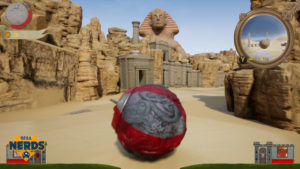 There are no boulders that are perfect in every situation, but there will no doubt be ones that you prefer, due to your play style. Boulders have different statistics based on: Strength, Speed, Acceleration, Damage and Weight. Each of them affect how well they handle across different types of courses and against different types of weapons.
There are no boulders that are perfect in every situation, but there will no doubt be ones that you prefer, due to your play style. Boulders have different statistics based on: Strength, Speed, Acceleration, Damage and Weight. Each of them affect how well they handle across different types of courses and against different types of weapons.
Each boulder looks unique and many of them have additional bonuses/advantages – such as the Angel Boulder being able to double jump, whereas the Globe Boulder has a moon spinning around it, so it can damage nearby obstacles without receiving any damage.
I think most gamers will enjoy the Monkey Ball aspect of the game – it’s really fun rolling over enemy structures and satisfying destroying the castle door first – but the tower defense side of things is equally enjoyable.
While this side of the game does slow things down, it can be brilliant fun to watch your tactics play out well. Essentially, after you have smashed your boulder into the opposing castle, you need to wait for your new boulder to be built, and this is the time to ready your defenses.
When I first played, I just dropped defenses anywhere on the course, not really caring or bothering to observe how well they worked. But after losing one early level three times in a row, I decided to take notice, and that’s when things clicked for me.

Rather than dropping defenses all over the map, the best solution is to pick defenses that complement each other and put them in close proximity (I often put them near my castle, because that tended to have the best space for lots of defenses). Once I worked out a good strategy, the tower defense bits became a real joy for me, as I tried to ready them in time before my enemy was able to roll.
If everything works out well, and you continuously destroy the enemy boulder before it can reach your castle, you can unlock a ‘rare’ achievement for destroying the enemy without taking any damage. I’m happy to say I was able to do this, and it’s a really satisfying feeling seeing your defenses work perfectly.
Chip off the old block

There’s not just a single player to Bigger and Boulder, there’s also some decent offline and online multiplayer modes, including 2-player co-op across the whole single-player campaign – where you both are able to create your defenses at the same time, on the same course and roll your boulders into the enemy structures. But be warned, the AI also has two boulders in this mode, so you will need those extra defenses to fend them both off.
There’s also additional game modes, for both single and multiplayer, which extend the gameplay further, plus plenty of boulders, defenses and customization options to unlock during the main campaign.
Offline, you can only ever have two human players, which is a bit of a shame. Though online you can have up to four players in game modes, two players per console.
The single-player campaign also mixes things up slightly with four boss battles, which take you away from the downhill slopes of normal levels and to battle-type arenas. I’m not sure if everyone will enjoy these, though I did find them a good break from the norm in the campaign.

You missed a spot
While I found the majority of my time with Bigger and Boulder to be really enjoyable, there are some things that hindered it.
Firstly, I came across some bugs in the game, one of which ruined the game for my girlfriend. See, she’s not a gamer, and Bigger and Boulder seemed like the perfect game for us both to play – as it is very easy to pick up.

After showing her the tutorial and playing a practice match against her, she picked things up, and we were ready to fight together against the AI. But something kept going wrong with her camera – every time she fell or was pushed off the course, her camera kept swinging around, so it was facing the wrong way. This led to her going backwards up the course and getting frustrated with the game. At first, I thought she was holding down the stick to change the camera angle, but I paid close attention the next time it happened, and sure enough, when she was placed back on the course, her camera was backwards.
The game does try to give you subtle indications on the direction you need to go, but it’s not always clear, especially for someone trying to get used to the controls.
Unfortunately, she became so annoyed with the game she gave up. It’s a shame because she thought it looked really fun when I was playing it, but I don’t blame her for quitting. Strangely, this camera situation never occurred for me in single player, but it was definitely happening to her.

Another annoyance is that to play two-player co-op offline, you need to create a separate Xbox Live account for the second player. There’s no option, like in other games, to just have a guest account. Frankly, this is ridiculous.
I also encountered a game-breaking bug against the Sphinx boss (see image to the left) and accidentally hit the “restart level” button once or twice. Couldn’t they have added a confirmation option?
Even if those annoyances didn’t exist, the biggest downside for Bigger and Boulder is that the game does feel rather repetitive during long gameplay stints. Even with the different boulders, new weapons and varied courses, you’re essentially doing to the same thing over and over again. But it’s great fun for short blasts of gaming!
Another point to note is that the campaign mode isn’t very long (it can be done in about 4-6 hours). But don’t let that put you off as the game is only £11.99/$14.99, and the amount of gameplay across the modes is well worth the entry fee.

Summary
Rock of Ages 2: Bigger and Boulder is a really enjoyable game and unique enough to warrant a purchase. While it has some flaws, some of which I’m hoping can be ironed out with an update, it is let down solely on its repetition during long gameplay stints.
But the game has enough variety in its level designs and content there for single and multiplayers, that it will keep bringing you back, even after you complete the main campaign.
While the visual aspects of the game don’t push modern hardware, the quirky art styles and imagination put into each level really draws players in, with a cracking soundtrack to roll your way to victory to. The odd humour may not be for everyone, but the gameplay should be enough to draw people in and keep them there.
Pros:
+ Really fun mix of gameplay styles
+ Great visuals bring historical & mythological characters/settings to life
+ Excellent soundtrack complements aesthetics
+ Good selection of game modes and unlockables
Cons:
– Can feel repetitive in long play sessions
– You need a second Xbox Live account to play multiplayer offline – WTF?
– Bug! Camera kept twisting round in two player co-op



